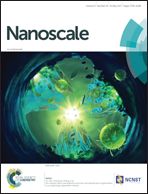Direct observation of breathing dynamics at the mismatch induced DNA bubble with nanometre accuracy: a smFRET study†
Abstract
The detailed conformational dynamics of the melted region in double-stranded DNA has been studied using a combination of ensemble and single-molecule FRET techniques. We monitored the millisecond time scale fluctuation kinetics of the two strands at the bubble region that varies with the size of the bubble. As the individual strands at the melting bubble behave as single-stranded DNA, and hence fluctuate dynamically to attain energetically favored configurations, the rates of these fluctuations increase with increase in the bubble size. In different short DNAs under investigation, the two strands never cross each other to form a knot, irrespective of the number of base pair mismatches present. Rather, they prefer to stay apart from each other, as the size of the bubble increases and follow exactly an opposite trend for bubbles of smaller size. The range within which the bubble strands fluctuate are monitored with great accuracy in the nanometre resolution from the single-molecule FRET measurements. The shape of the bubble that plays a crucial role in determining the activity of the DNA was speculated. These results shall be useful in quantifying the chemical processes within DNA as well as to develop a deeper understanding of the activity of the DNA due to induced mismatches.



 Please wait while we load your content...
Please wait while we load your content...